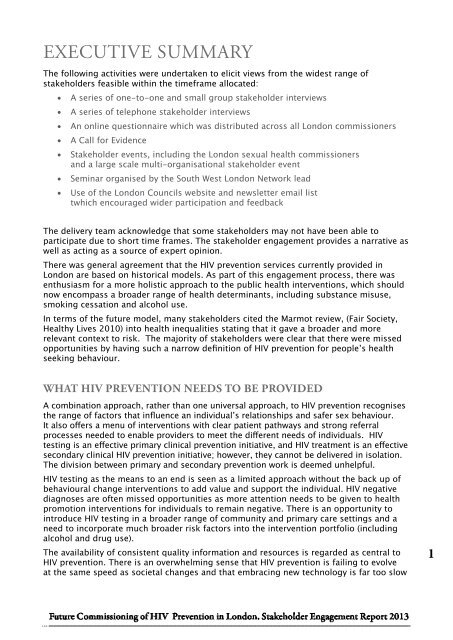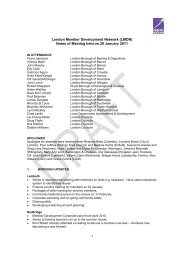Stakeholder Engagement Report - London Councils
Stakeholder Engagement Report - London Councils
Stakeholder Engagement Report - London Councils
You also want an ePaper? Increase the reach of your titles
YUMPU automatically turns print PDFs into web optimized ePapers that Google loves.
Executive summary<br />
The following activities were undertaken to elicit views from the widest range of<br />
stakeholders feasible within the timeframe allocated:<br />
• A series of one-to-one and small group stakeholder interviews<br />
• A series of telephone stakeholder interviews<br />
• An online questionnaire which was distributed across all <strong>London</strong> commissioners<br />
• A Call for Evidence<br />
• <strong>Stakeholder</strong> events, including the <strong>London</strong> sexual health commissioners<br />
and a large scale multi-organisational stakeholder event<br />
• Seminar organised by the South West <strong>London</strong> Network lead<br />
• Use of the <strong>London</strong> <strong>Councils</strong> website and newsletter email list<br />
twhich encouraged wider participation and feedback<br />
The delivery team acknowledge that some stakeholders may not have been able to<br />
participate due to short time frames. The stakeholder engagement provides a narrative as<br />
well as acting as a source of expert opinion.<br />
There was general agreement that the HIV prevention services currently provided in<br />
<strong>London</strong> are based on historical models. As part of this engagement process, there was<br />
enthusiasm for a more holistic approach to the public health interventions, which should<br />
now encompass a broader range of health determinants, including substance misuse,<br />
smoking cessation and alcohol use.<br />
In terms of the future model, many stakeholders cited the Marmot review, (Fair Society,<br />
Healthy Lives 2010) into health inequalities stating that it gave a broader and more<br />
relevant context to risk. The majority of stakeholders were clear that there were missed<br />
opportunities by having such a narrow definition of HIV prevention for people’s health<br />
seeking behaviour.<br />
What HIV prevention needs to be provided<br />
A combination approach, rather than one universal approach, to HIV prevention recognises<br />
the range of factors that influence an individual’s relationships and safer sex behaviour.<br />
It also offers a menu of interventions with clear patient pathways and strong referral<br />
processes needed to enable providers to meet the different needs of individuals. HIV<br />
testing is an effective primary clinical prevention initiative, and HIV treatment is an effective<br />
secondary clinical HIV prevention initiative; however, they cannot be delivered in isolation.<br />
The division between primary and secondary prevention work is deemed unhelpful.<br />
HIV testing as the means to an end is seen as a limited approach without the back up of<br />
behavioural change interventions to add value and support the individual. HIV negative<br />
diagnoses are often missed opportunities as more attention needs to be given to health<br />
promotion interventions for individuals to remain negative. There is an opportunity to<br />
introduce HIV testing in a broader range of community and primary care settings and a<br />
need to incorporate much broader risk factors into the intervention portfolio (including<br />
alcohol and drug use).<br />
The availability of consistent quality information and resources is regarded as central to<br />
HIV prevention. There is an overwhelming sense that HIV prevention is failing to evolve<br />
at the same speed as societal changes and that embracing new technology is far too slow<br />
1




